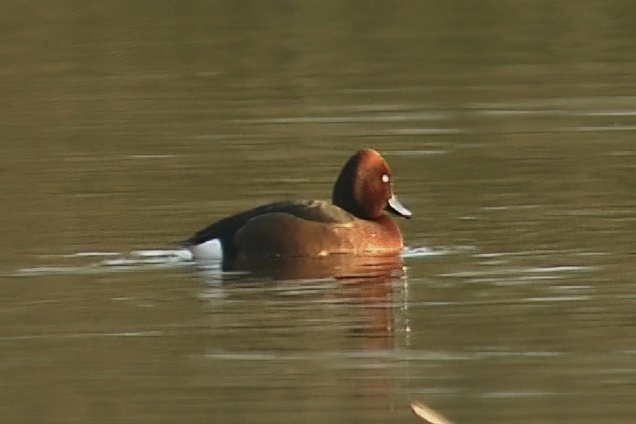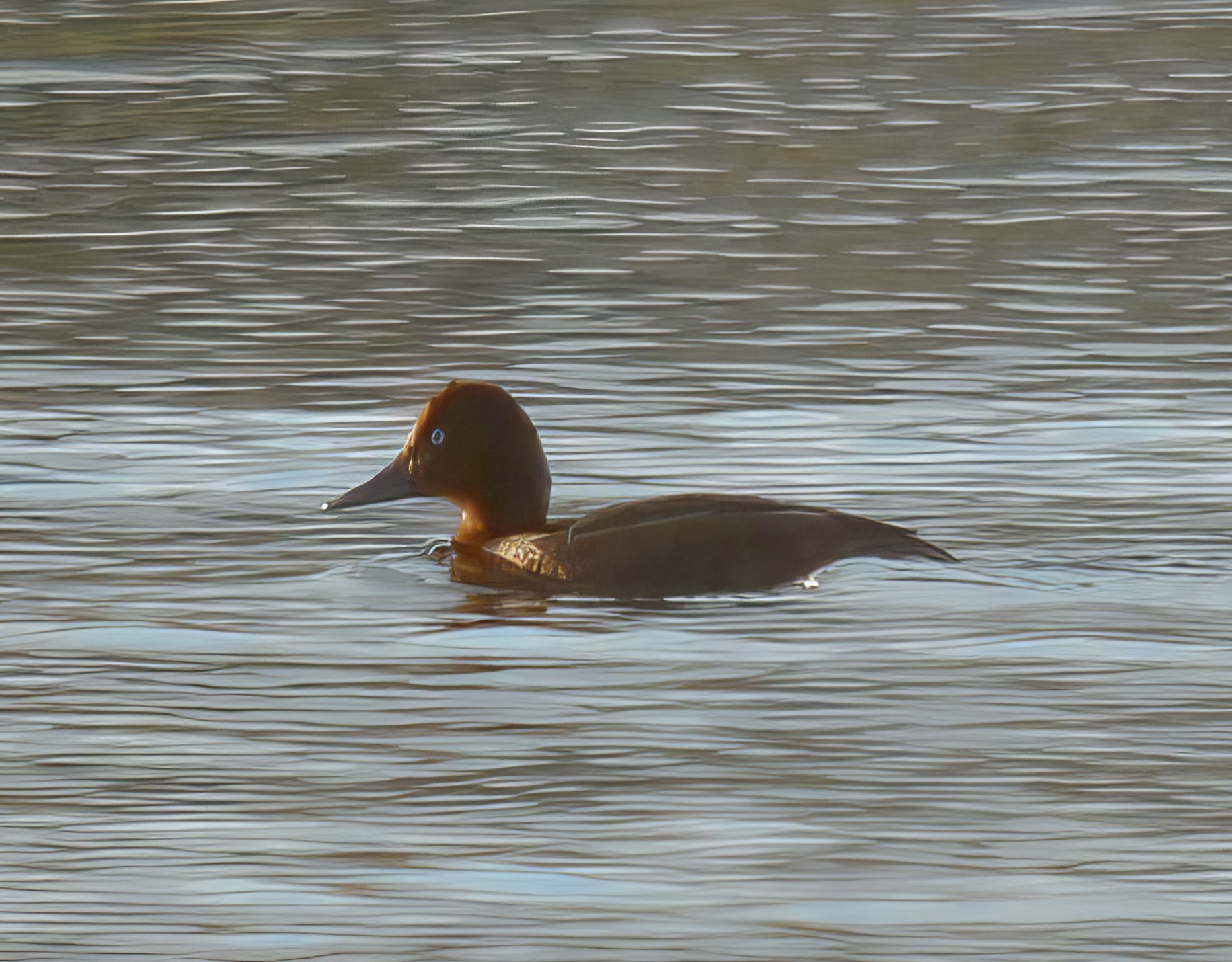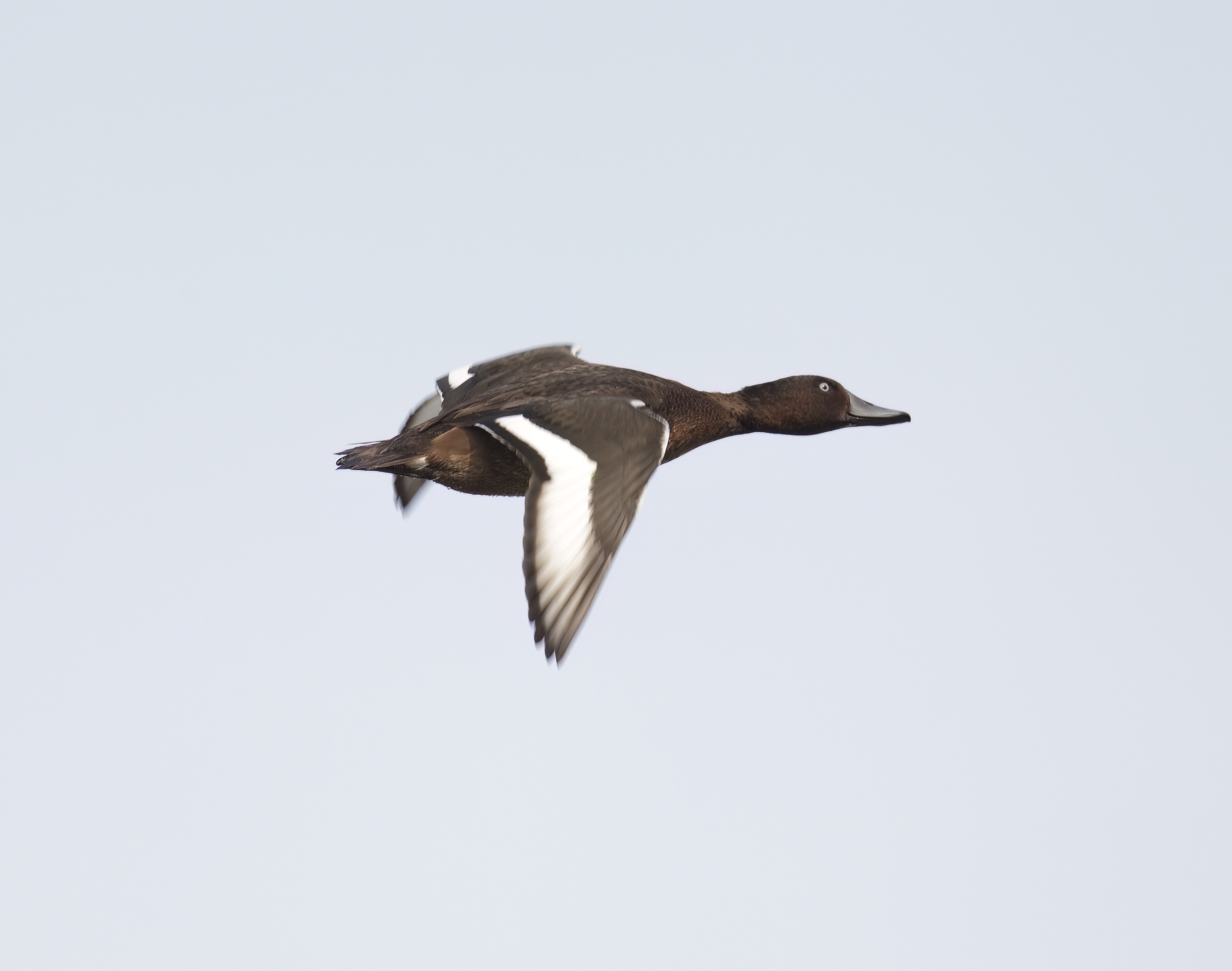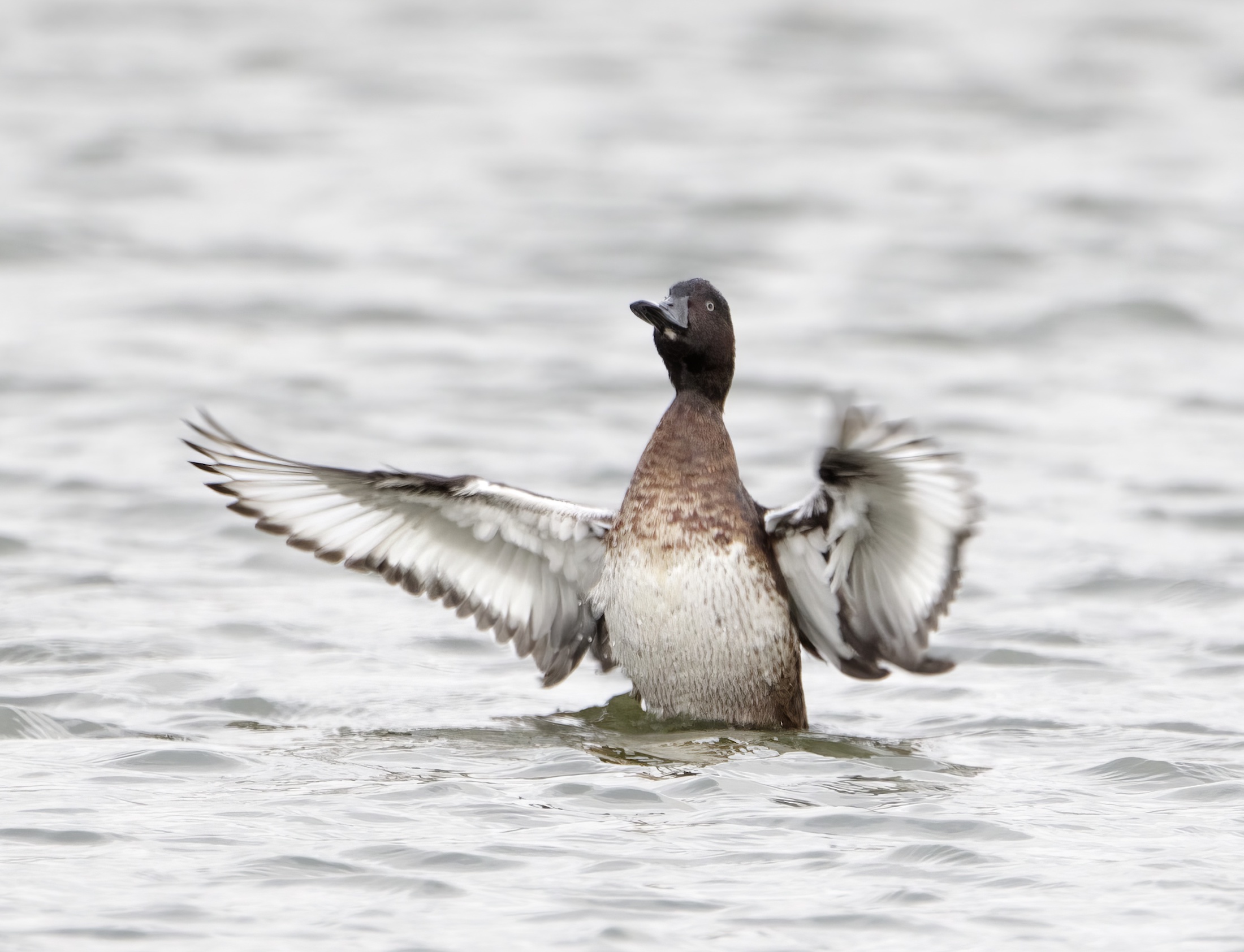Ferruginous Duck Aythya nyroca
Vagrant, occurring mainly in autumn and winter; less frequent than formerly. Eastern Europe.


Ferruginous Ducks: left, Water's Edge CP February 16th-March 18th 2001 (Graham Catley); right, Whisby CP January 9th 2009 (Russell Hayes).
The first county record is of at least one bird (unsexed) at Newsham Lake on the Brocklesby Estate February 3rd-24th,1929. It remains a rare bird in county with 17 more records since then involving 16 individuals. Of those birds which were sexed only the bird in 1959 was considered a female. Eight have occurred during both January-March and September-December, and there are two summer records in July. All have been on inland freshwater bodies with the exception of one at Goxhill Marsh in 1960. Six long-stayers were present 19-31 days, the remainder nine days or less with six being one-day birds.
There have been 685 British records 1950-2018 and Ferruginous Duck was removed from the list of species considered by BBRC after 2005, remaining so up to 2016. However, due to its growing scarcity during that period, it was re-instated from 2017 onwards. It should be noted that there are difficulties in assessing some records with complications including escapes from captivity, birds from the German reintroduction scheme launched in 2011, and associated hybrids with other Aythya species.
| Site | First date | Last date | Count | Notes |
| Newsham Lake, Brocklesby Estate | 03/02/1929 | 24/02/1029 | 1-2 | |
| Holywell, Stamford | 25/12/1957 | 27/12/1957 | 1 | Male |
| Baston GP | 21/11/1959 | - | 1 | Female, shot |
| Goxhill marsh | 04/09/1960 | 26/09/1960 | 1 | Male |
| Wisbech STW | 22/07/1972 | 10/08/1972 | 1 | Male |
| Boston | 16/03/1974 | 24/03/1974 | 1 | Male |
| Covenham Reservoir | 04/11/1974 | 05/11/1974 | 1 | Male |
| Chapel Pit, Chapel St Leonards | 11/07/1976 | - | 1 | Male |
| Chapel Pit, Chapel St Leonards | 24/01/1980 | 30/01/1980 | 1 | Male |
| North and South Killingholme Pits | 05/03/1981 | 06/03/1981 | 1 | Male |
| Kirkby GP | 18/10/1998 | 05/11/1998 | 1 | Male on and off between these dates |
| Kirkby GP | 10/12/1998 | - | 1 | Male, presumed same as Oct/Nov bird |
| Water's Edge CP | 16/02/2001 | 18/04/2001 | 1 | Male |
| Huttoft Pit LWT reserve | 25/02/2007 | - | 1 | Sex indeterminate |
| Huttoft Pit LWT reserve | 15/06/2007 | - | 1 | Presumed same as bird of 25/02 |
| Whisby quarry silt lagoons | 05/01/2009 | 31/01/2009 | 1 | Male, commuted between Whisby and a nearby private lake |
| Glentworth | 06/10/2009 | 11/10/2009 | 1 | Eclipse male on a private reservoir |
| Langtoft GP | 17/11/2023 | - | 1 | Adult male |
| West Deeping lakes | 12/09/2024 | 14/09/2024 | 1 | 3CY+ male (also seen in Nottinghamshire) |
| Baston & Langtoft GP and Tallington Lakes | 02/11/2024 | 22/03/2025 | 1 | 3CY+ male, same mobile bird |
Finder’s report: Ferruginous Duck at Goxhill marsh, September 4th, 1960, fourth county record.
by D. A. Robinson.
Note: this account is taken from correspondence between DAR and Geoff Pyman, secretary of the Rarity Records Committee (as BBRC was known then). This is the first account we have on file, the fourth county record.
Circumstances
The duck was seen four times in all, the first being September 4th, which was a showery overcast day when I saw it at 10.30 am, on a disused brick pit about 100 yd. from the Humber bank. The pit, about one acre in extent, only had an area of about 40 x 60 yds, the rest being overgrown by reeds. It was settled on the water by itself about 5 seconds before it took to the wing on seeing myself appear through the reeds only 5 yd. away, on this occasion. I only had a chance to note its red-brown appearance on the water and white undertail coverts and wing bar as it flew off.
It was seen the following day around midday in bright sunlight at a distance of about 50 yd. in another pit about 100 yd. from the first but with the same area of reed and water, by Mr van den Bos. He watched it for half an hour and left without putting it out. He also saw it some days later on the same pit, but I have not got the date in my notes.
It was last seen by myself on September 26th; the notes I made, and description were sent with the original report to the LNU, and I take it you have a copy. It was six o’clock in the evening when I arrived at the pit and the duck was surface feeding amongst water crowfoot at distances varying between 15 and 30 yd. In a short time, it left the water to preen on the mudbank before returning to the water where I left it at 7.15 pm. Other ducks present on the pit on this occasion were 12 Mallard, one Shoveler (drake) and 16 Teal, but the Ferruginous Duck kept pretty much to itself all the time. The light was good, and I had the sun behind me until it started to set around the time I left.
Although we visited the pits regularly, mostly once a day, and sometimes twice to count waders these are the only occasions on which the duck was seen. I take it that it was the same individual each time. Neither of us has observed this species in the wild before.
Mr van den Bos uses 10 x 50 Barr and Stroud and myself 10 x 50 Zeiss binoculars.
Description
Red-brown head and neck, and sides of body until it reached white patch under tail. The white patch about two inches wide under tail from side to side. Bill blue-grey. Wings and back dark brown, not red-brown as on head and mantle. White flash shows on last two primaries when sat on water. White under belly seen as it preened standing on mud. Surface feeding among water crowfoot most of the time, dabbling. Head slightly darker red than rest of body.
Ferruginous Duck hybrids


1CY male hybrid Ferruginous Duck x (probably) Tufted Duck, Barton Pits, October 8th-November 4th 2011 (Graham Catley).
Hybrids between Ferruginous Duck and other diving ducks are regularly recorded in the UK. Those involving a Common Pochard A. ferina parent may turn out as follows: (a) with male Common Pochard, often resembling Redheads A. americana) (b) with male Ferruginous Duck and (c) female Ferruginous Duck look very similar to pure Ferruginous Ducks. Hybrids between Ferruginous Duck and Red-crested Pochard, Southern Pochard Netta erythrophthalma, Baer’s Pochard A. baeri, Tufted Duck and even Marbled Duck Marmaronetta angustirostris and the near-extinct Madagascar Pochard A. innotata are known. Needless to say those hybrids in the UK usually involve Tufted Duck or Common Pochard. One such example involving Tufted Duck x Ferruginous Duck parentage was a 1CY drake present at Barton Pits from October 8th to November 4th 2011, returning in September 2012, initially identified as a Ferruginous Duck. Although similar to a pure Ferruginous Duck, detailed observations and photographs gave rise to concerns over its head colour (brown, but not mahogany), crown shape (not peaked enough) and bill shape (too long) and raised the possibility that it might have been a hybrid. The bill also had black extending back from the nail along the cutting edges and it had a white band behind the black nail. By the time it returned in 2012, the iris was bright white. The consensus was that this was a Ferruginous Duck to a large degree but not 100% - what was the parentage? Common Pochard is the species most commonly involved, and hybrids may resemble either parent. In addition to this individual, other hybrids have been recorded (table).
| Site | First date | Last date | Count | Notes |
| Sutton Ings Pit | 28/02/1982 | 06/03/1982 | 1 | |
| Sutton Ings Pit | 18/12/1982 | 28/12/1982 | 1 | Different bird from that of Feb/Mar |
| Thorpe Pits, Lincoln | 24/11/1984 | 25/11/1984 | 1 | With a female Tufted Duck |
| Barrow Haven | 14/11/1987 | - | 1 | Female |
| New Holland | 24/04/1993 | - | 1 | Male |
| Barton Pits | 05/12/1993 | - | 1 | Male, presumed same as New Holland bird. |
| Barton Pits | 08/10/2011 | 04/11/2011 | 1 | 1CY male |
| Barton Pits | 12/09/2012 | 29/09/2012 | 1 | 2CY+ male, presumed returming bird of 2011. |
| Tallington Lakes | 29/12/2020 | 03/01/2021 | 1 | AdM, long-staying bird |
Reference
Vinicombe, K.E. (2000). Identification of Ferruginous Duck and its status in Britain and Ireland. British Birds 93: 4-21.
(Account as per new Birds of Lincolnshire (2021), included September 2022)

